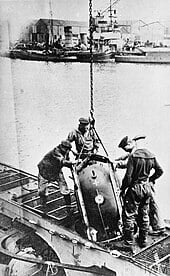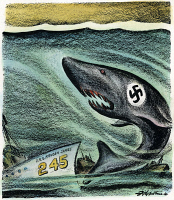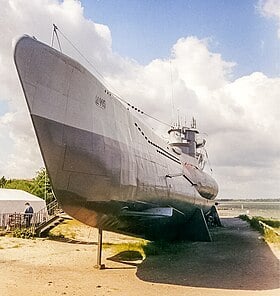All About U-Boats
The Development of U-Boats and Submarine Warfare
And their impact on the world
The Evolution of Submarine Warfare
Submarines have a long and fascinating history, with their origins dating back centuries before they became the staple of naval warfare.
Though rudimentary submarine technology existed as early as the Renaissance era, it wasn’t until World War I that submarines—specifically German U-boats—were used in mass-produced fleets to devastating effect. These silent and hidden predators forever changed naval strategy and warfare, striking fear into merchant and military ships alike.
Early Submarine Designs: From Da Vinci to the Civil War
The concept of submarines can be traced back to Leonardo da Vinci, who sketched out an early design for an underwater vessel in the 16th century. However, the first functional submarine is often credited to Cornelis Drebbel, a Dutch inventor who successfully tested a submersible craft for the English navy in the early 1600s.
By the American Civil War, submarines had progressed significantly. The H.L. Hunley, a Confederate submarine, became the first combat submarine to successfully sink an enemy warship when it took down the USS Housatonic in 1864. This marked the first demonstration of submarines as offensive naval weapons.
U-Boats in World War I: Germany’s Silent Hunters

During World War I, Germany led the world in submarine innovation, creating the first modern fleets of military submarines, known as U-boats (short for “Unterseeboot,” meaning "undersea boat"). These vessels operated stealthily beneath the waves, launching surprise attacks on enemy warships and merchant vessels alike. Their use of torpedoes and aquatic mines gave Germany a powerful advantage at sea.
The U-boat campaign against Britain’s Royal Navy and merchant fleet was devastating. In 1914 alone, U-boats sank over 214,000 tons of British ships. By the war’s end, they had sunk a staggering 12.8 million tons of Allied ships.
The Lusitania, a British passenger liner, was famously sunk by U-boat U-20 in 1915, resulting in the deaths of 1,198 people and intensifying American opposition to Germany’s naval tactics.
The Most Infamous U-Boat Captains
- Lothar von Arnauld de la Perière: Holds the record for the most tonnage sunk (over 400,000 tons in just ten patrols).
- Walter Forstmann: Known for highly effective strikes on Allied shipping.
- Hans Rose & Otto Steinbrinck: Conducted numerous deadly patrols in British waters.
Their tactics, including unrestricted submarine warfare, led to great destruction but also contributed to turning neutral countries against Germany.
The Psychological Impact of U-Boats on Naval Warfare
U-boats introduced a new kind of fear in naval combat with an unseen enemy lurking below the surface. Unlike traditional battles, where enemy ships could be spotted on the horizon, U-boats struck without warning, leaving sailors with no time to react.
Survivors of U-boat attacks often recounted the terror of being stranded at sea, watching their ships sink while U-boats disappeared into the depths. This unseen menace affected morale among Allied forces, leading to new psychological warfare strategies such as false radio broadcasts and decoy ships meant to lure U-boats into the open.
U-Boats in World War II: The Battle for the Atlantic

By the time World War II erupted, submarine technology had advanced significantly. Germany once again relied on its U-boats, launching an even deadlier campaign in the Battle of the Atlantic. These submarines formed the backbone of Germany’s naval warfare, operating in “wolfpacks”—coordinated groups that ambushed convoys and warships.
The early years of the war saw massive success for U-boats, sinking thousands of Allied ships, but new developments in radar, sonar, and codebreaking allowed the Allies to turn the tide. Depth charges, air patrols, and improved convoy systems meant that by 1943, U-boats were no longer the dominating force they had been.
U-Boats in Unlikely Waters: Operations Beyond the Atlantic
While the Battle of the Atlantic was the primary theater for U-boats, they also operated in unexpected locations:
- The Arctic Ocean: German U-boats attempted to disrupt Allied supply lines to the Soviet Union.
- The Indian Ocean & Caribbean Sea: U-boats attacked British and American supply routes.
- U.S. Coastal Waters: Some of the most surprising U-boat attacks happened mere miles from the U.S. shoreline, showing just how far-reaching the threat was.
The Influence of U-Boats on Modern Submarine Technology

The need to stay submerged for longer periods led to major breakthroughs in submarine technology:
- The Schnorchel (Snorkel) System: Allowed U-boats to run their diesel engines while fully submerged.
- Acoustic Homing Torpedoes: Could track enemy vessels based on sound, making evasive maneuvers very difficult.
- Hydrodynamic Designs: Made modern submarines faster and more efficient underwater.
U-Boats in the Cold War and Beyond
After Germany’s defeat in 1945, the Allies captured U-boats and studied their technology, leading to major advancements in submarine warfare.
The Soviet Union reverse-engineered German U-boat designs, creating some of the most advanced Cold War-era submarines. The United States also incorporated U-boat innovations into its own fleet, leading to the development of nuclear-powered submarines in the 1950s.
The Legacy of U-Boats Today
These vessels forever changed the nature of naval warfare and influenced the development of modern submarines used by navies worldwide.
At Gettysburg Flag Works, military history has a special place in our hearts. By offering a wide selection of historical flags, military banners, and commemorative flags, we hope to spread the American pride we feel towards our country and the freedom we get to live with.
Whether you’re looking for historical naval flags, World War II banners, or custom military flags, we’re here to help you find the perfect tribute.
Explore our collection of historical flags and military-themed products, or contact us today—we’re always happy to help!